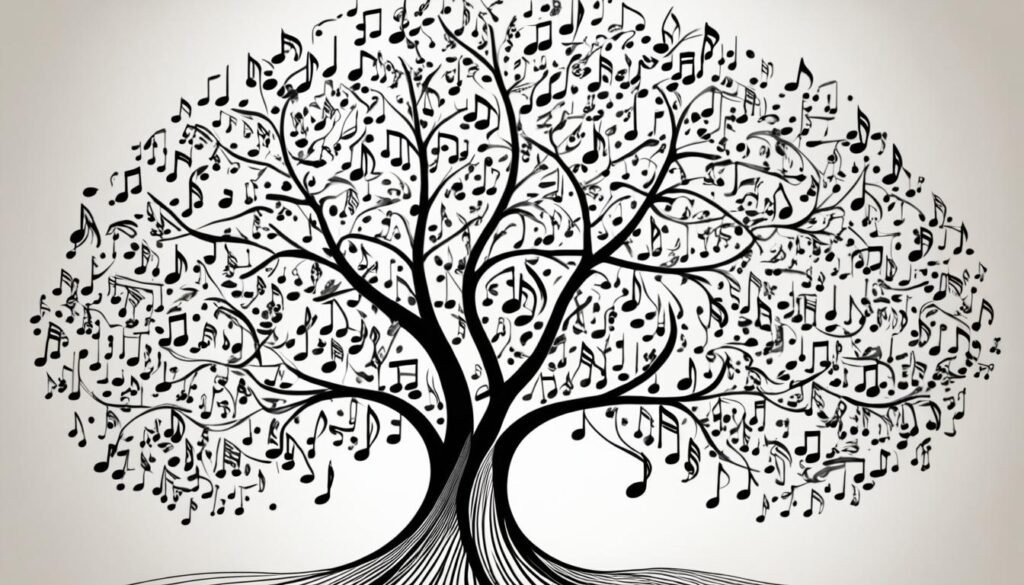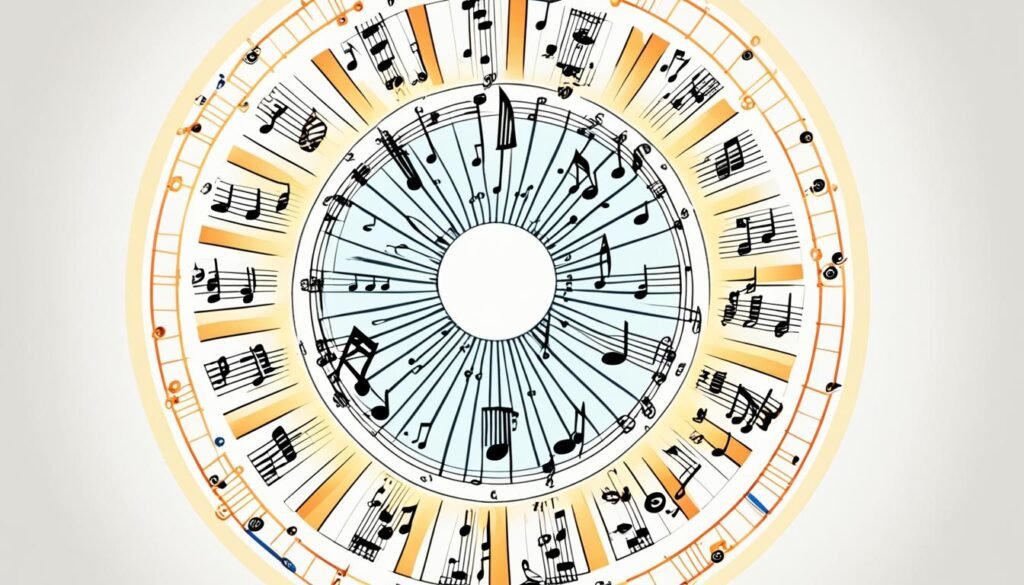Welcome to our crash course in music theory, where we’ll explore the basics of this fundamental aspect of music. Understanding these basics is key to developing a deeper appreciation and understanding of the language of music. Whether you’re a musician or simply a music lover, learning the fundamentals of music theory will enhance your overall experience and enjoyment of music.
Music theory is the foundation of Western music, providing a framework for composers, performers, and listeners. It allows us to understand the structure, relationships, and expressive elements within a piece of music. In this course, we’ll dive into the fundamental concepts without the need to read sheet music. Professor Robert Greenberg will guide us through the world of music theory, focusing on listening and exploring musical syntax.
By delving into the elements of music, such as melody, rhythm, harmony, and scales, we’ll gain a solid grounding in the basics of music theory. We’ll learn how these elements shape compositions and contribute to the emotional impact of different genres. Through Professor Greenberg’s engaging teaching style, we’ll develop the skills to critically listen to music and appreciate its intricate beauty.
Key Takeaways:
- Music theory is the language of Western music
- Understanding the basics of music theory enhances our appreciation and comprehension of music
- In this course, Professor Robert Greenberg provides a crash course in music theory without the need to read sheet music
- By focusing on listening and exploring musical syntax, this course deepens our understanding of compositional structures
- Developing critical listening skills and a deeper appreciation for music are some of the benefits of learning music theory
The Language of Music
The language of music is a captivating and diverse form of expression that transcends cultural boundaries. Professor Robert Greenberg introduces the concept of musical syntax, highlighting how it can be comprehended through the act of listening rather than relying solely on deciphering sheet music. By exploring the fundamental elements of music, including timbre, beat, tempo, and pitch, individuals can develop a deeper understanding and appreciation of this art form, regardless of their level of musical education.
In understanding the language of music, listeners are able to discern the intricate patterns and structures within compositions, allowing for a more enriched musical experience. The melodic and rhythmic components, interwoven with dynamics and tonal variations, create a unique vocabulary that enables musicians and music enthusiasts to communicate and connect on a profound level.
“Music gives a soul to the universe, wings to the mind, flight to the imagination, and life to everything.” – Plato
| Musical Element | Description |
|---|---|
| Timbre | The unique tone quality or color of a sound produced by an instrument or voice. |
| Beat | The underlying pulse or rhythm that provides structure to a piece of music. |
| Tempo | The speed at which the music is played or performed. |
| Pitch | The highness or lowness of a sound, determining its musical tone. |
Listening to music becomes a captivating journey as individuals develop their comprehension of musical syntax. Without the need for sheet music, individuals can begin to grasp the intricate relationships between various musical elements. This deeper understanding allows for a heightened appreciation of the complexity and creativity that composers utilize in their works.
Timbre: The Color of Sound
Timbre, also known as musical timbre, is a fundamental aspect of music that adds depth and character to its composition. It refers to the unique color or quality of sound produced by different instruments or voices. Just like how each person has a distinct voice, every instrument has its own timbre, creating a symphony of musical speech.
The exploration of timbre allows listeners to appreciate the expressive power of different instruments and voices in music. By listening to various timbres and understanding their characteristics, we can discern subtle nuances that contribute to the richness and emotional impact of a musical piece.
“Timbre is like the fingerprint of an instrument or voice. It’s what sets them apart and makes them recognizable. Exploring the different timbres in music is like discovering new colors and shades in a painting.” – Professor Robert Greenberg
Some instruments have a bright and vibrant timbre, while others have a mellow or dark timbre. The interaction of different timbres creates a tapestry of sound, allowing musicians and composers to convey specific emotions and narratives through their compositions.
The Role of Timbre in Musical Speech
Timbre plays a crucial role in creating musical speech, allowing instruments and voices to communicate and convey meaning. Just like how different accents and voices convey distinct emotions in spoken language, the timbre of an instrument or voice adds depth and texture to the musical message.
For example, the warm and velvety timbre of a saxophone can evoke feelings of nostalgia or romance, while the crisp and percussive timbre of a snare drum can create tension and excitement. By understanding and appreciating the unique qualities of each instrument’s timbre, listeners can engage with the musical speech on a more profound level.

Exploring Timbre through Comparison
To further understand the concept of timbre, let’s compare the timbres of different instruments:
| Instrument | Timbre Characteristics |
|---|---|
| Violin | Warm, expressive, and resonant |
| Trumpet | Bright, bold, and brassy |
| Cello | Rich, deep, and melodious |
As shown in the table above, different instruments produce unique timbres that can be described using specific characteristics. Exploring the timbres of instruments allows us to appreciate their distinct qualities and the role they play in shaping the overall musical experience.
By delving into the world of timbre, we can unlock a deeper understanding and appreciation for the vast expressions and emotions that music has to offer.
The Elements of Rhythm
Rhythm is an essential element of music that underlies its structure and movement. It is what gives music its groove and energy, driving the listener to tap their feet and sway along. In this section, we will explore the key components of rhythm, including beat, tempo, and meter, and how they work together to create dynamic and engaging musical compositions.

The Beat
The beat is the pulse or steady recurring pattern that defines the rhythm of a piece of music. It serves as the foundation upon which all other rhythmic elements are built. The beat can be felt or heard as a regular and consistent pattern that guides the listener through the music. Whether it’s a toe-tapping rhythm in a catchy pop song or a driving drumbeat in a rock anthem, the beat provides a sense of order and cohesion within a musical composition.
The Tempo
Tempo refers to the speed or pace at which a musical piece is performed. It determines how fast or slow the beat is perceived by the listener. Tempo can greatly influence the mood and energy of a composition. A fast tempo creates a sense of excitement and urgency, while a slow tempo evokes a feeling of calmness or introspection. Musicians use tempo to express their intentions and convey emotions through their performances.
The Meter
Meter is the organization of beats into regular groups, creating patterns of accents and emphasis within a musical composition. It helps establish the overall structure and timing of the music. Common meters include duple meter (two beats per measure), triple meter (three beats per measure), and quadruple meter (four beats per measure). Meter provides a sense of stability and predictability, allowing listeners to follow and anticipate the rhythmic patterns in a piece of music.
“Rhythm is the heart and soul of music. It’s what makes us move, groove, and feel the music in our bones.”
Understanding the elements of rhythm is essential for musicians and music enthusiasts alike. It allows us to appreciate the various rhythmic patterns and dynamics present in different genres of music. By discerning the beat, feeling the tempo, and recognizing the meter, we can fully immerse ourselves in the rhythmic world of music, finding joy and connection through its captivating language.
The Power of Melody
Melody, the succession of notes or voices that form a musical phrase, holds a profound role in shaping musical compositions. It is the soulful thread that weaves through various genres of music, captivating listeners and conveying emotions with its melodic beauty and expressiveness. Understanding the concepts of pitch, rhythm, and melodic motion allows us to unravel the enchanting power of melody in music.
“Melody is the essence of music. It has the power to uplift our spirits, evoke memories, and touch our souls.” – Professor Greenberg
Pitch, the perceived highness or lowness of a sound, is a fundamental element of melody. It gives melody its distinct character and allows us to recognize and differentiate between different musical phrases. Additionally, rhythm provides the rhythmic framework on which melody thrives, ensuring a coherent and cohesive musical experience.
Moreover, melodic motion, the movement of melody from one note to another, adds depth and richness to musical compositions. It can be ascending, descending, or even oscillating, creating tension, release, and musical variety. The graceful ebb and flow of melodic motion captivate our ears and keep us engaged throughout the piece.
Whether it’s the haunting melodies of classical symphonies, the catchy hooks of pop songs, or the intricate improvisations of jazz solos, the power of melody is universal. It touches our hearts, transcends language barriers, and resonates with our emotions.

The image above beautifully captures the essence of melody in music, showcasing the interconnectedness of notes and the flow of melodic motion. It reminds us of the power that melodies hold in transforming mere sounds into captivating and memorable musical experiences.
As we delve deeper into the world of music theory, let us embrace the captivating power of melody and appreciate its ability to transcend boundaries, create emotional connections, and enrich our lives.
The Harmonic Foundations
Harmony is the beautiful art of combining multiple notes or voices to create a new sound that is greater than the sum of its parts. It is the backbone of musical composition and plays a fundamental role in shaping the emotional impact of a piece. In this section, we will delve into the harmonic foundations of music, exploring the essence of harmony, the significance of chords, and the power of chord progressions. Let’s unlock the secrets of consonant harmony and discover how it brings musical compositions to life.
The Essence of Harmony
At its core, musical harmony is about creating a sense of unity and balance through the interaction of different musical elements. It is the art of combining melodies, rhythms, and textures in a way that is pleasing to the ear. Harmony provides depth and structure to a composition, guiding the listener through a musical journey filled with tension and release, dissonance and resolution.
The Significance of Chords
Chords are the building blocks of harmony, forming the backbone of musical accompaniment and providing the harmonic support to melodies. They are formed by combining three or more notes played simultaneously, creating a rich and full sound. Chords can evoke different emotions and moods depending on their composition and placement within a musical piece. Understanding and utilizing chords effectively is essential for creating harmonic depth and complexity in music.
The Power of Chord Progressions
Chord progressions are sequences of chords that define the harmonic structure of a composition. They serve as the framework that guides the listener through a musical piece, creating tension and release, and building emotional impact. By exploring different chord progressions, composers can evoke a wide range of emotions, from melancholy and introspection to joy and triumph. Understanding and analyzing chord progressions can provide valuable insights into the creative choices made by composers and enrich our overall appreciation of music.
| Chord Type | Symbol | Example |
|---|---|---|
| Major | Maj or no symbol | C, E, G (C Major) |
| Minor | m or – | C, Eb, G (C Minor) |
| Diminished | o or ° | C, Eb, Gb (C Diminished) |
| Augmented | + | C, E, G# (C Augmented) |
“Harmony is like a glorious symphony, blending different voices into a unified whole, creating a world of emotional depth and beauty.” – Professor Robert Greenberg
By delving into the harmonic foundations of music, we gain a deeper understanding of how harmonies shape musical compositions and create emotional impact. The combination of chords, chord progressions, and consonant harmony creates a musical language that speaks directly to our hearts and souls. Let’s explore the power of harmony and unlock the secrets of its enchanting melodies.
Exploring Scales and Modes
Scales and modes are fundamental elements in the world of music. They provide the framework and tonal foundation for countless compositions. In this section, we will delve into the fascinating world of scales and modes, including major and minor scales, and explore how they create unique tonalities and moods in music.
The Importance of Scales
Scales are a sequence of notes or pitches arranged in ascending or descending order. They serve as the building blocks of melodies, harmonies, and chords. Major scales, with their bright and uplifting sound, are widely used in various genres of music, from classical to pop. Minor scales, on the other hand, evoke a sense of melancholy and introspection, often found in blues, jazz, and classical compositions.
Understanding major and minor scales allows musicians to navigate through different tonalities and develop a deeper understanding of harmony and melody. By grasping the patterns and intervals within these scales, musicians can create expressive and captivating musical phrases.
Exploring Modes
Modes are alternate variations of scales, each with its own unique character and mood. They add depth and complexity to musical compositions, providing different tonal colors and flavors. One of the most famous modes is the Ionian mode, which is essentially the major scale. Other modes, such as Dorian, Phrygian, and Mixolydian, offer distinct tonalities and can be found in various genres, including rock, jazz, and folk music.
“Modes provide musicians with a versatile palette of sounds and emotions to work with. From the playful and mysterious Dorian mode to the exotic and intense Phrygian mode, each mode presents new possibilities for musical expression and creativity.” – Professor Greenberg
Unveiling the Musical Secrets
To truly appreciate the nuances and intricacies of music, it is essential to explore and understand scales and modes. By recognizing the role they play in shaping melodies, harmonies, and tonalities, listeners can gain a deeper appreciation for the artistry and creativity behind different compositions.
Now, let’s dive into the world of scales and modes with Professor Greenberg as our guide:
“Prepare to embark on a musical journey filled with enchanting scales, captivating melodies, and the exploration of different tonalities. Together, we will unravel the magic behind the scales and modes that make music come alive.” – Professor Greenberg

Continue your exploration of scales and modes with Professor Greenberg in the upcoming section as we delve deeper into the world of key signatures and the circle of fifths.
Key Signatures and Circle of Fifths
In music theory, key signatures and the circle of fifths play a crucial role in understanding the tonality of a piece of music. Key signatures are visual symbols placed at the beginning of a staff to indicate the key of a composition. They help establish the tonal center or the home note around which the entire piece revolves. The circle of fifths is a graphical representation that illustrates the relationships between different musical keys based on the interval of a fifth.
The Concept of Key Signatures
Key signatures provide valuable information about the tonal characteristics of a piece of music and help musicians identify the specific key in which it is written. They consist of a series of sharps (#) or flats (b) placed next to the clef at the beginning of a staff. Each sharp or flat symbolizes a specific note that will be consistently raised or lowered throughout the composition.
For example, a key signature with one sharp indicates that the composition is written in the key of G major or its relative minor, E minor. The sharp sign is placed next to the note F, indicating that all F notes in the piece should be played as F#.
Key signatures are essential for understanding the tonality and harmonic structure of a composition. By recognizing the key signature, musicians can anticipate the notes that are likely to appear in the music and better interpret the melodic and harmonic intentions of the composer.
The Circle of Fifths
The circle of fifths is a visual representation that organizes all twelve musical keys based on their relationships to one another. It is constructed by arranging the keys in a circular pattern, moving clockwise in ascending fifths (or descending fourths).
The circle of fifths is a powerful tool for musicians to understand the relationships and transitions between keys. By following the circle, you can easily determine the key signature of any major or minor key, identify closely related keys, and analyze harmonic progressions within a piece of music.

Summary Table: Common Key Signatures
| Major Key | Key Signature | Relative Minor Key | Key Signature |
|---|---|---|---|
| C Major | No sharp or flat | A Minor | No sharp or flat |
| G Major | 1 sharps (#) | E Minor | 1 sharps (#) |
| D Major | 2 sharps (#) | B Minor | 2 sharps (#) |
| A Major | 3 sharps (#) | F# Minor | 3 sharps (#) |
| E Major | 4 sharps (#) | C# Minor | 4 sharps (#) |
| B Major | 5 sharps (#) | G# Minor | 5 sharps (#) |
| F# Major | 6 sharps (#) | D# Minor | 6 sharps (#) |
| C# Major | 7 sharps (#) | A# Minor | 7 sharps (#) |
Table: Common Key Signatures
Understanding key signatures and the circle of fifths is essential for musicians and music enthusiasts seeking a deeper comprehension of tonality and harmonic relationships in music. By analyzing key signatures and exploring the circle of fifths, listeners can unlock insights into the structure, mood, and emotional impact of different musical keys.
Understanding Intervals and Tunings
Intervals play a crucial role in the creation of harmonic and melodic structures in music. In this section, we will delve into the concept of intervals and explore the intricate relationships between notes. By understanding intervals and different tuning systems, you can develop a deeper appreciation for the beauty and complexity of musical compositions.
An interval refers to the distance between two notes. It determines the relationship between the pitches, which can be expressed in terms of half steps or whole steps. Different intervals create different feelings and moods within a piece of music.
Did you know? The interval of a perfect fifth is often considered the most harmonious and pleasing to the ear. It can be found in many popular melodies and harmonies throughout history.
The Importance of Intervals in Music
Intervals serve as the building blocks for melodies and harmonies as they define the distance and relationship between notes. They help create tension, resolution, and emotional impact within a piece.
Here are some common intervals and their characteristics:
| Interval | Description |
|---|---|
| Unison | The same pitch, no distance between notes |
| Major Second | A whole step between notes |
| Minor Third | A half step smaller than a major third |
| Perfect Fourth | A perfect consonant interval with a distinctive sound |
| Major Sixth | Six notes apart, with a bright and open sound |
| Minor Seventh | One half step smaller than a major seventh |
| Octave | Twelve notes apart, creating a sense of completion and unity |
Understanding intervals allows musicians to choose specific combinations of notes to evoke particular emotions and create unique musical phrases. It also helps in the analysis and interpretation of music.
Texture, Harmony, and Modulation
In the realm of music, texture, harmony, and modulation play vital roles in shaping the overall structure and expression of a composition. Understanding these concepts is key to unlocking a deeper appreciation for the richness and complexity of different genres of music.
Texture refers to the way musical voices and melodies interact with each other. It can be categorized into different types, such as monophonic (a single melody line), homophonic (melody with accompanying chords), or polyphonic (multiple independent melodies). The texture of a piece can greatly impact its emotional impact and overall aesthetic.
Harmony is the art of combining different musical notes to create chords and chord progressions. It establishes the vertical aspect of music, providing a foundation for melody and creating a sense of consonance or dissonance. Harmonic progression involves the movement from one chord to another, adding depth and complexity to a musical piece.
Modulation refers to the process of changing from one key or tonal center to another within a musical composition. It adds variety, tension, and interest to the music by altering the emotional character and providing a sense of movement and exploration.
Professor Greenberg once stated, “Texture, harmony, and modulation are the secret ingredients that breathe life into music, enabling composers to create harmonically interesting and compelling musical journeys.”
By studying texture, harmony, and modulation, listeners can develop a keen ear for recognizing different musical textures, understanding the impact of harmonic progressions, and sensing the subtle yet powerful shifts in tonality and modulation. This knowledge adds depth and nuance to one’s musical experience, allowing for a greater need for a crash course appreciation and enjoyment of music in all its forms.
Understanding Musical Texture
In music, texture refers to the way different musical voices or melodies interact with each other to create a harmonious whole. It determines the overall sonic quality and richness of a musical piece. There are different types of musical texture:
- Monophonic: A single melodic line, without any accompaniment.
- Homophonic: A melody accompanied by chords or other harmonic elements.
- Polyphonic: Multiple independent melodic lines interacting with each other.
Each type of texture offers a unique listening experience, from the stark simplicity of a monophonic texture to the intricate interplay of multiple voices in polyphony.
The Role of Harmony in Music
Harmony is the art of combining different musical notes to create chords and chord progressions. It establishes the vertical aspect of music, providing a foundation for melody and creating a sense of consonance or dissonance. Harmonic progressions, the movement from one chord to another, play a crucial role in shaping the emotional character and structure of a musical composition. From a simple three-chord progression to complex harmonic sequences, harmony adds depth, tension, and complexity to the overall musical experience.
Exploring Modulation in Music
Modulation adds variety and interest to a musical composition by changing from one key or tonal center to another. It provides a sense of movement and exploration, transitioning the listener to a new tonal landscape. Modulation can evoke different emotions and create contrasting moods within a piece of music. Whether it is a smooth transition or a dramatic shift, modulation adds depth and complexity, keeping the listener engaged and captivated.
The Benefits of Music Theory
Learning music theory has numerous benefits for musicians and music lovers. It is a key tool for enhancing musical development, fostering creativity, and improving critical listening skills. Understanding music theory allows musicians to delve deeper into the art of composition, improvisation, and arrangement, unlocking a world of possibilities for musical expression and basics is key to becoming.
Here are some of the key benefits of studying music theory:
- Improved Musical Development: By learning music theory, musicians can gain a deeper understanding of the fundamental principles that govern music. This knowledge enriches their musical repertoire and enables them to experiment with different styles and genres, contributing to their overall growth as musicians.
- Enhanced Creativity: Music theory provides a foundation for creative exploration. It helps musicians in developing original musical ideas, exploring unique chord progressions, modulations, and melodic structures. Understanding the theory behind music allows musicians to innovate and express their individuality in their compositions.
- Better Critical Listening Skills: Studying music theory trains the ear to recognize and analyze different musical elements, such as harmony, melody, rhythm, and timbre. This heightened awareness improves critical listening skills, enabling musicians to appreciate and decipher complex musical compositions, and ultimately enhancing their interpretative abilities.
“Music theory is to a musician what grammar is to a writer. It provides a foundation and structure upon which creativity can flourish.”
Moreover, understanding music theory not only benefits professional musicians but also enriches the musical experience for music lovers. It allows them to engage more deeply with the nuances and intricacies of the music they listen to, fostering a greater appreciation and understanding of the art form.
Musical Composition and Arrangement
One of the significant advantages of studying music theory is its impact on musical composition and arrangement. By understanding the principles of harmony, chord progressions, and musical form, composers can create more cohesive and meaningful musical pieces. This knowledge empowers them to harness the full potential of musical elements, tailoring compositions to evoke specific emotions and convey their intended message.
Furthering Musical Development
Music theory provides a strong foundation for musicians to expand their musical horizons. As they delve into the complexities of scales, modes, and musical structures, they can explore different genres and styles, broadening their musical vocabulary. This knowledge equips musicians with the tools to adapt and navigate various musical contexts, enhancing their versatility as performers.
The Importance of Critical Listening Skills
Developing critical listening skills is essential for both musicians and music history lovers alike. By understanding the structural and formal elements of music through music theory, listeners can actively engage with the music they encounter. They can discern intricate harmonies, recognize melodic patterns, and appreciate the technical aspects of a performance. This cultivates a deeper connection with the music and enables listeners to articulate their musical preferences more effectively.
Ultimately, music theory acts as a bridge between the theoretical and the practical, providing a framework for musical exploration and growth. Whether one is a professional musician, an aspiring composer, or an avid music enthusiast, the benefits of studying music theory cannot be overstated.
| Benefits of Music Theory |
|---|
| Improved musical development |
| Enhanced creativity |
| Better critical listening skills |
By honing their knowledge of music theory, individuals can unlock their full creative potential, deepen their understanding of the intricacies of music, and embark on a lifelong journey of musical exploration.
Also Read : Soothing Background Music For Work & Relaxation
Conclusion
Understanding the fundamentals of music theory is crucial for developing a well-rounded musical foundation. Throughout this course, we have explored the language of music and delved into elements such as timbre, rhythm, melody, harmony, and scales. By deepening our understanding of these key concepts, we can enhance our appreciation and unlock the secrets of music composition and expression.
The study of music theory provides invaluable benefits for musicians and music lovers alike. It enables musicians to develop their musical skills, enhance their creativity, and improve their critical listening abilities. With a solid understanding of music theory, musicians can compose, arrange, and improvise music with greater confidence and precision.
For music lovers, learning music theory allows us to delve deeper into the intricacies of the music we enjoy, unraveling the complexities and appreciating the artistry behind each composition. It enables us to analyze and interpret musical structures, enhancing our listening experience and fostering a deeper connection with the music we love.
FAQ
Q: What is Music Theory 101: Understanding the Fundamentals?
A: Music Theory 101: Understanding the Fundamentals is a comprehensive instruction on the basics of music theory, essential for beginners and even professional musicians.
Q: Why should I learn about music theory 101?
A: Learning music theory 101 is key to becoming a well-rounded music lover. It provides the essential guide you need to understand music symbols and history.
Q: What can I expect from the Adams 101 Series on music theory?
A: The Adams 101 Series offers easy-to-understand visual aids of scales and topics related to music theory that even professional musicians would envy.
Q: Is Music Theory 101 full of music trivia?
A: Yes, Music Theory 101 is full of music trivia and covers the basics of music theory in an engaging and informative way.
Q: Do I need prior knowledge to start reading Music Theory 101?
A: No, Music Theory 101 is designed for beginners and does not require any prior knowledge of music theory. It is perfect for those who need a crash course in the fundamentals.
Q: How does Music Theory 101 help guitar players who don’t read music?
A: Music Theory 101 provides a practical guide to understanding music theory for guitar players who don’t read music. It explains the essentials of music theory in a way that is accessible to all.
Q: Where can I find the Adams 101 Series on music theory?
A: The Adams 101 Series on music theory can be purchased on Amazon.com. It is a well-written book that covers the basics of music theory and is a must-have for music enthusiasts.




